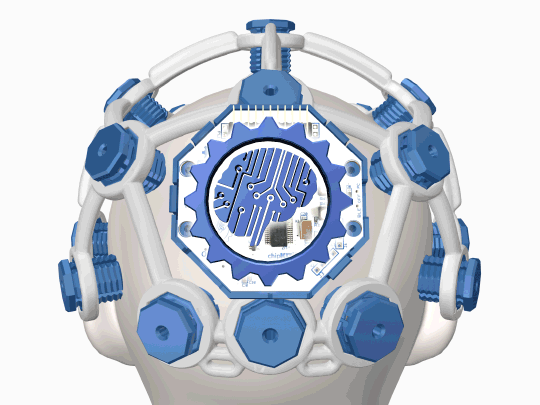

For several years, Connor Russomanno and Joel Murphy have been designing brain-computer interfaces (BCIs) as part of their company, OpenBCI. It’s a tricky proposition; subtle brain waves can be measured, but it’s difficult to read them and even more difficult to control them. So for its latest device, the team launched a crowdfunding campaign for the BCI Ganglion, a sub-$100 device to measure brain, muscle, and heart activity. (Tracking muscles in addition to electrical signals from the scalp increases accuracy.)
They also announced the Ultracortex Mark IV, a 3D printable headset designed to hold electrodes for electrical measurements by the Ganglion. Unlike existing devices that accomplish similar data acquisition, the Ganglion and Ultracortex Mark IV are open source (hardware and software), supported by an active user community, and lower in cost by thousands of dollars.
This means whether you want to record brainwaves for research purposes or create a brain-computer interface between five friends and a flying shark, it is possible and even affordable. In one particularly far-out project, the TransAtlantic Biodata Communication hackathon, one person wired with OpenBCI was able to control a second person also wearing the device — even on opposite sides of the ocean.

But whether it’s wacky experiments, practical home projects, or academic research, the Ganglion offers a number of tools and sensors for various applications.
Specifications
- 4 channel biosensors
- 128, 256, 512 and 1024 sample rates
- Used for EEG, EMG, or ECG
- Wireless BLE connection with Simblee, an Arduino compatible BLE radio module
- SD card slot for local storage
- Accelerometer
- Connects wirelessly to the OpenBCI Processing sketch
The Ultracortex Mark IV is not ready at launch; the headset is currently in the concept stage of development. But not to worry, previous headsets from OpenBCI are compatible with the new Ganglion. Here are the design specifications the team is working on:
- Simplified assembly
- Higher node count (especially above the motor cortex & the visual cortex)
- Increased comfort
How the Ganglion works
Interfacing the human brain with computers is all about monitoring electrical activity. The Ultracortex Mark IV holds electrodes against your head and they are wired to the Ganglion. The Ganglion monitors the electrical activity of neurons in the brain at each electrode — also known as brainwaves.
From a computing perspective, the brainwaves constitute series of analog values, which the Ganglion samples and converts to digital values. This conversion is done using a specialized chip on the Ganglion known as an analog-to-digital converter (ADC). ADC chips are common in all sorts of electronics, not just BCI devices. If you have used an Arduino to read an analog sensor values, then you have used an ADC.

While the ADC chip OpenBCI used in the past was extremely powerful, it accounts for much of the cost of the device. The predecessor to the Ganglion, the OpenBCI 32-bit board, used a robust Texas Instruments ADS1299 which cost a whopping $36 per unit at quantity and $58 in low volume. While the ADS1299 chip is fantastic for sampling, it was way more advanced and expensive than most people want. When Russomanno and Murphy set out to lower the cost of their BCI device, the first thing they did was find a cheaper ADC. They were able to swap out the $36 chip with a much more affordable $6 ADC.
Cutting their cost for their last BCI board by nearly $400, the OpenBCI team is pushing the expectations for high-quality, low cost science devices. Asked what defines a successfully crowdfunding campaign apart from reaching a financial goal, Russomanno explains: “It is lowering the barrier to entry” and “getting the entire OpenBCI platform so it’s approachable by a passionate high schooler or undergraduate.”

ADVERTISEMENT





